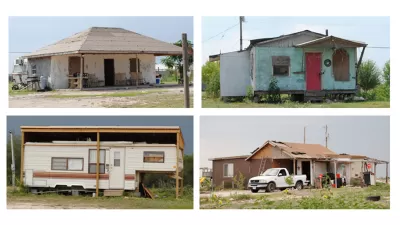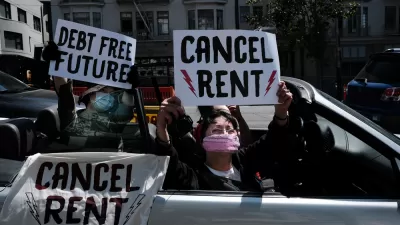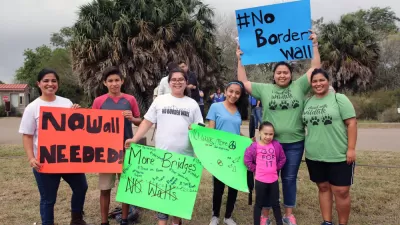Guest blogger Noah J. Durst writes about his new article in JPER.

Nearly half a million Texans live in what are known as colonias—low-income, self-help communities along the Mexico border that often lack basic water and waste water infrastructure and are characterized by some of the worst quality housing in the nation. A 1989 law made it illegal to subdivide and sell land without basic water and waste water infrastructure. Yet little has been done to address the shortage of affordable housing for low-income families in Texas and, as a result, thousands of families find themselves struggling with many of the same burdens of self-help housing that were widespread in colonias.
Although these new "model subdivisions" (named after the law that aimed to prevent the spread of colonias) are equipped with water, waste water (septic systems, primarily), electricity, and paved roads, they are still characterized by self-help housing such as that shown in Figure 1. In Texas, it seems that self-help is still the primary means by which many poor families access housing they can afford.

Unlike home buyers in middle class neighborhoods, buyers in model subdivisions typically begin by purchasing a vacant lot from a land developer. Down payments and monthly purchase costs are typically quite low—often less than $400 down and $400 a month. These low prices are a key selling point (see billboard advertisement in Figure 2), but they are also accompanied by sky-high interest rates upwards of 12-15 percent per year (Durst & Ward, 2016). As many as 50 percent of buyers in some neighborhoods lose the property within the first two years (Olmedo & Ward, 2016).
They buyers who remain typically buy a used—and often severely dilapidated—trailer, and spend the next 10 to 20 years building a home themselves through self-help. Figure 2 shows the range of housing found in a model subdivision known as Pueblo de Palmas ("Palm Village") in Hidalgo County, Texas. Dwellings often take the form of dilapidated campers (often improvised with connections to self-built stick-frame structures or roofs), self-built and unfinished stand-alone homes, and abandoned dwellings whose owners have likely walked away from the investment.

Due to the low and intermittent incomes of buyers in model subdivisions, self-help is necessarily a long and uncertain process. This is shown visually in Figure 3, which uses Google Earth to track a single neighborhood in Hidalgo County, Texas over ten years. Many families live in poor-quality, unfinished, and cramped homes while they save the money needed to expand or improve the dwelling.

As I describe in my recent article in the Journal of Planning Education and Research (free link until June, 17), since the early 1990s tens of thousands of Texas' poorest families have purchased vacant lots in model subdivisions. As shown in Table 1, across the seven counties that I studied, the number of lots developed since 1990 largely mirrors the change in poverty between 1990 and 2010. This suggests that self-help housing is still the de facto affordable housing policy in many of the poorest parts of Texas.

Although the Model Subdivision Rules succeeded in preventing the spread of colonias without basic infrastructure, the new self-help communities that I refer to as model subdivisions still pose considerable challenges for local planners, policymakers, and housing advocates. For example, although the requirement that developers install water and waste water infrastructure has eliminated the most severe health risks associated with self-help housing, it also appears to have increased the cost of land. This in turn has made one of the few affordable housing options available to poor households considerably less affordable. In places such as Laredo, Texas (in Webb County), where no new model subdivisions have been developed but the number of poor families has risen by more than 4,000 since 1990, the elimination of the self-help market has led to dramatic increases in the cost of land and, ironically, to the illegal subdivision of lots in colonias as families have tried to cope with the housing shortfall.
Many of the challenges posed by model subdivisions arise because they still lack the amenities that suburban residents elsewhere take for granted. For example, streetlights are non-existent in the vast majority of these neighborhoods, and given the safety risks associated with poorly lit streets, they are highly coveted by residents. In some places such as Hidalgo County, local residents have begun to demand (and succeed in demanding) that county governments install streetlights in established self-help communities (Durst and Ward, 2016).
Although installing streetlights in older neighborhoods is more expensive than doing so at the time of electricity installation, it is far easier than installing new sewer systems in older neighborhoods—and that is precisely the fate that awaits many model subdivisions. As cities grow they will run up against low-density model subdivisions whose half-acre lots make poor use of space and rely on septic systems that are not equipped for dense suburban housing. These systems will therefore need upgrading or replacing with sewer systems. Cities are unlikely to make this sort of investment and, as they have done with colonias (Durst, 2014), they will likely refuse to annex model subdivisions given the high cost of infrastructure and housing investment that they require.
The responsibility will therefore once again fall to county, state, and federal governments to make the necessary investments in infrastructure and housing in model subdivisions. However, due to the peculiarities of federal colonias legislation, model subdivisions are ineligible for HUD’s Community Development Block Grant set-aside funds because they developed after the passage of the Affordable Housing Act of 1990.
Many of the challenges presented by the spread of colonias are now being repeated as model subdivisions proliferate throughout Texas. My paper in the Journal of Planning Education and Research describes the extent and nature of these communities and highlights the need for renewed attention by planners, policymakers, and housing advocates to the promise and peril of self-help housing in Texas.
Noah Durst is a doctoral candidate in Public Policy at University of Texas, Austin.
Read the full article, free for a month" Durst, Noah J. "The Nature and Extent of Self-Help Housing in Texas From Colonias to Model Subdivisions." Journal of Planning Education and Research (2015): 0739456X15612199.
Durst, N. J. (2014). Municipal annexation and the selective underbounding of colonias in Texas’ Lower Rio Grande Valley. Environment and Planning, 46(7), 1699–1715. http://doi.org/10.1068/a130038p
Durst, N. J., & Ward, P. M. (2016). Colonia Housing Conditions in Model Subdivisions: A Déjà Vu for Policy Makers. Housing Policy Debate, 26(2), 316–333. http://doi.org/10.1080/10511482.2015.1068826
Olmedo, C., & Ward, P. M. (2016). Model subdivisions: The new face of developer lot sales for low-income colonia-type housing in Texas. Land Use Policy, 52, 181–194. http://doi.org/10.1016/j.landusepol.2015.12.003

Depopulation Patterns Get Weird
A recent ranking of “declining” cities heavily features some of the most expensive cities in the country — including New York City and a half-dozen in the San Francisco Bay Area.

California Exodus: Population Drops Below 39 Million
Never mind the 40 million that demographers predicted the Golden State would reach by 2018. The state's population dipped below 39 million to 38.965 million last July, according to Census data released in March, the lowest since 2015.

Pennsylvania Mall Conversion Bill Passes House
If passed, the bill would promote the adaptive reuse of defunct commercial buildings.

Google Maps Introduces New Transit, EV Features
It will now be easier to find electric car charging stations and transit options.

Ohio Lawmakers Propose Incentivizing Housing Production
A proposed bill would take a carrot approach to stimulating housing production through a grant program that would reward cities that implement pro-housing policies.

Chicago Awarded $2M Reconnecting Communities Grant
Community advocates say the city’s plan may not do enough to reverse the negative impacts of a major expressway.
City of Costa Mesa
Licking County
Barrett Planning Group LLC
HUD's Office of Policy Development and Research
Mpact Transit + Community
HUD's Office of Policy Development and Research
City of Universal City TX
ULI Northwest Arkansas
Town of Zionsville
Write for Planetizen
Urban Design for Planners 1: Software Tools
This six-course series explores essential urban design concepts using open source software and equips planners with the tools they need to participate fully in the urban design process.
Planning for Universal Design
Learn the tools for implementing Universal Design in planning regulations.



























